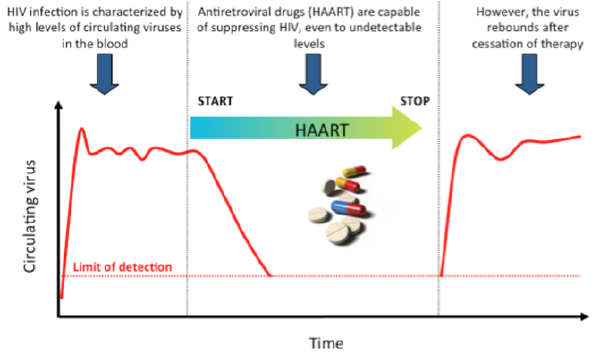Dans la même rubrique
-
Partager cette page
Reactivation of HIV-1 gene expression to treat persistent HIV infection [Offre de technologie]
The technology in a nutshell
New drug combination with efficient cART used as a therapeutic perspective to decrease latent HIV-1.
State of the art
Despite current effective and life-prolonging cART, HIV-1 can still not be cured. Indeed, the persistence of latently-infected resting CD4+ T cells harboring transcriptionally silent but replication competent HIV-1 proviruses seriously challenge the hope of HIV-1 eradication from cART-treated HIV-1 infected patients. Reactivation of HIV-1 expression in reservoirs together with an efficient cART has been proposed as an adjuvant therapy aimed at reaching a functional cure.
Several studies have identified individual compounds that are capable of reversing HIV-1 latency and several clinical trials have started. However, these studies question the efficiency of these drugs used alone and underly the importance to further test other classes of HIV-1 inducers, alone or in combination, to reduce the HIV-1 reservoirs.
The invention
The combined use of two drugs to activate latent HIV could cause a synergistic reactivation of HIV-1 production. Indeed, a proof-of-concept has been demonstrated by inventors for the coadministration of two different types of therapeutically promising HIV-1 inducers [DNA methylation inhibitors in combination with histone deacethylase inhibitors (HDACis) or histone methyltransferase inhibitors (HMTis) in combination with HDACi or NF-kappaB inducers] together with efficient cART as a therapeutic perspective to decrease the pool of latent HIV-1 reservoirs.
Commercial interest
Key advantage of the technology
- limit exposure to the anti-AIDS molecules, thereby limiting side effects → the life quality of the patients would be greatly improved.
- reduce the care costs for HIV+ patients.
The inventors
Carine VAN LINT is Professor and Director of the Service of Molecular Virology at ULB, Belgium and Research Director of the Belgian National Fund for Scientific Research (FNRS). After performing her PhD thesis at the National Institutes of Health (NIH,Bethesda, USA) and a post-doctoral fellowship in New-York, she joined ULB. She is author and co-author of more than 85 international peer-reviewed publications in the field of retrovirology and molecular biology (EMBO J., PNAS, Science). She is laureate of the Pharmacia 2002 Scientific Prize (FNRS and Pharmacia Society), of the Biennial 2003 Prize of the Princess Josephine-Charlotte Study Center (FNRS) and of the Atomia 2014 Prize (Innoviris).
Olivier ROHR is Professor of Physiology at the University of Strasbourg. He is head of the DHPI Lab from the institute of Parasitology and tropical pathology of Strasbourg (IPPTS). Olivier Rohr is a member of the «Institut Universitaire de France» (IUF). Olivier ROHR studies HIV latency and the related molecular mechanisms.
Sophie BOUCHAT is a PhD Student supervised by Carine VAN LINT at ULB and funded by the Belgian ‘Fonds pour la Recherche dans l’Industrie et l’Agriculture’ (FRIA). She studies HIV-1 reactivation from latency and potential therapeutic implications. She received a prize for the best Poster presentation at the ISHEID 2012 meeting.
Jean-Stéphane GATOT has performed a post-doctoral fellowship at ULB in Carine VAN LINT’s lab and was funded by the “CIBLES” Excellence program of the Walloon Region.
The team
Olivier ROHR ´s Lab from the University of Strasbourg collaborates with Carine Van Lint for the study of the molecular mechanisms regulating HIV latency.
Relevant publication
- Histone methyltransferase inhibitors induce HIV-1 recovery in resting CD4+ T cells from HIV-1+ HAART-treated patients. Bouchat S., Gatot JS., Kabeya K., Cardona C., Colin L., Herbein G., de Wit S., Clumeck N., Lambotte O., Rouzioux C., Rohr O., Van Lint C. Aids 2012, 26:1473-82. IF : 6,245
- HIV-1 transcription and latency: an update. Van Lint C., Bouchat S., Marcello A. Retrovirology 2013, 10: 67. IF: 5,660
Keywords
- HIV latency
- Anti-latency therapies
- Epigenetic drugs
Collaboration type
- Licence agreement
- R&D collaboration
IP status
- PCT application: WO2013050422 (Published in 2013-04-11)
Inventors
- Pr Van Lint C.
- Pr Rohr O.
- Dr Bouchat S.
- Dr Gatot JS.
Contact
ULB Research Department
Fred Pierard
IP Manager
+32 (0)2 650 32 26
frederic.pierard@ulb.be

